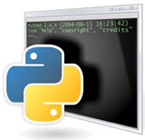
PythonTechnology
Python is a programming language that lets you work more quickly and integrate your systems more effectively. You can learn to use Python and see almost immediate gains in productivity and lower maintenance costs.
Python is a high-level, interpreted, interactive and object oriented-scripting language.
Python was designed to be highly readable which uses English keywords frequently where as other languages use punctuation and it has fewer syntactical constructions than other languages.
Python is a high-level, interpreted, interactive and object oriented-scripting language.
Python was designed to be highly readable which uses English keywords frequently where as other languages use punctuation and it has fewer syntactical constructions than other languages.

Python is Interpreted: This means that it is processed at runtime by the interpreter and you do not need to compile your program before executing it. This is similar to PERL and PHP. |
|
Python is Interactive: This means that you can actually sit at a Python prompt and interact with the interpreter directly to write your programs. |
|
Python is Object-Oriented: This means that Python supports Object-Oriented style or technique of programming that encapsulates code within objects. |
|
Python is Beginner's Language: Python is a great language for the beginner programmers and supports the development of a wide range of applications, from simple text processing to WWW browsers to games. |
| Python runs on Windows, Linux/Unix, Mac OS X, and has been ported to the Java and .NET virtual machines. | |||||||||||||||||||||||||||||||||||||||||||||||||||||||||||||||||||
| Python is free to use, even for commercial products, because of its OSI-approved open source license | |||||||||||||||||||||||||||||||||||||||||||||||||||||||||||||||||||
Python is an easy to learn, powerful programming language. It has efficient high-level data structures and a simple but effective approach to object-oriented programming. Python’s elegant syntax and dynamic typing, together with its interpreted nature, make it an ideal language for scripting and rapid application development in many areas on most platforms. |
|||||||||||||||||||||||||||||||||||||||||||||||||||||||||||||||||||
| History of Python: | |||||||||||||||||||||||||||||||||||||||||||||||||||||||||||||||||||
| Python was developed by Guido van Rossum in the late eighties and early nineties at the National Research Institute for Mathematics and Computer Science in the Netherlands. |
|||||||||||||||||||||||||||||||||||||||||||||||||||||||||||||||||||
| Python is derived from many other languages, including ABC, Modula-3, C, C++, Algol-68, SmallTalk, and Unix shell and other scripting languages. |
|||||||||||||||||||||||||||||||||||||||||||||||||||||||||||||||||||
| Python is copyrighted, Like Perl, Python source code is now available under the GNU General Public License (GPL). | |||||||||||||||||||||||||||||||||||||||||||||||||||||||||||||||||||
| Python is now maintained by a core development team at the institute, although Rossum still holds a vital role in directing it's progress. | |||||||||||||||||||||||||||||||||||||||||||||||||||||||||||||||||||
| Python is a remarkably powerful dynamic programming language that is used in a wide variety of application domains. Python is often compared to Tcl, Perl, Ruby, Scheme or Java. Some of its key distinguishing features include: |
|||||||||||||||||||||||||||||||||||||||||||||||||||||||||||||||||||
| Python Features: | |||||||||||||||||||||||||||||||||||||||||||||||||||||||||||||||||||
| Python's feature highlights include: | |||||||||||||||||||||||||||||||||||||||||||||||||||||||||||||||||||
|
|||||||||||||||||||||||||||||||||||||||||||||||||||||||||||||||||||
| The Python interpreter and the extensive standard library are freely available in source or binary form for all major platforms from the Python Web site, http://www.python.org/, and may be freely distributed. The same site also contains distributions of and pointers to many free third party Python modules, programs and tools, and additional documentation. |
|||||||||||||||||||||||||||||||||||||||||||||||||||||||||||||||||||
| The Python interpreter is easily extended with new functions and data types implemented in C or C++ (or other languages callable from C). Python is also suitable as an extension language for customizable applications. |
|||||||||||||||||||||||||||||||||||||||||||||||||||||||||||||||||||
| Benefits of using Python: | |||||||||||||||||||||||||||||||||||||||||||||||||||||||||||||||||||
Fans of Python use the phrase "batteries included" to describe the standard library, which covers everything from asynchronous processing to zip files. The language itself is a flexible powerhouse that can handle practically any problem domain. Build your own web server in three lines of code. Build flexible data-driven code using Python's powerful and dynamic introspection capabilities and advanced language features such as meta-classes, duck typing and decorators. |
|||||||||||||||||||||||||||||||||||||||||||||||||||||||||||||||||||
| Python lets you write the code you need, quickly. And, thanks to a highly optimized byte compiler and support libraries, Python code runs more than fast enough for most applications. |
|||||||||||||||||||||||||||||||||||||||||||||||||||||||||||||||||||
Social Networking

Technologies








